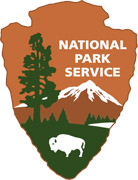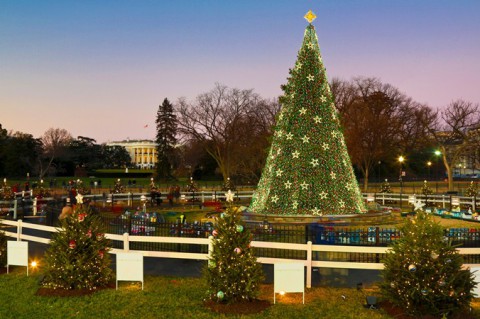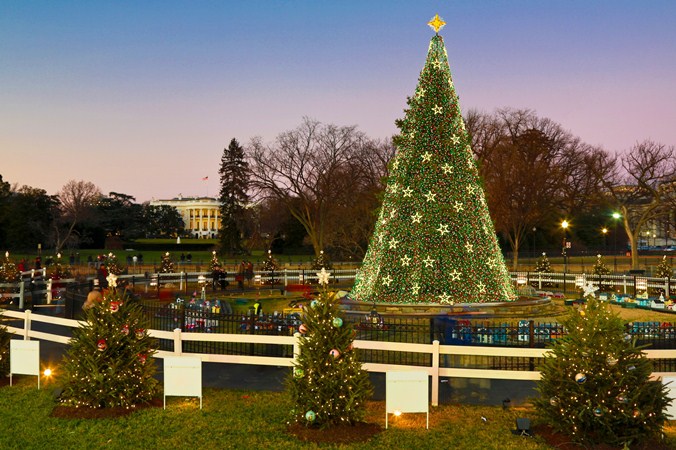US Capitol Christmas Tree and Other Forerunners to the National (Community) Christmas Tree
 Washington, D.C. – December 24th, 1913 was the first community Christmas celebration in Washington, D.C. On the East Plaza of the US Capitol on Christmas Eve, the Christmas tree and related pageantry occurred. It was meant as a celebration for all of Washington, rich and poor, young and old, although a special emphasis was placed on the children.1
Washington, D.C. – December 24th, 1913 was the first community Christmas celebration in Washington, D.C. On the East Plaza of the US Capitol on Christmas Eve, the Christmas tree and related pageantry occurred. It was meant as a celebration for all of Washington, rich and poor, young and old, although a special emphasis was placed on the children.1
The forty-five minute program, replete with angel figures in white robes, nativity tableaux, carols, and Boy Scouts waving American flags, was modeled largely on community celebrations in other cities.

(NPS PHOTO)
The US Marine Band and a chorus of 1,000 local singers entertained the crowd. So that no one would be left “wanting at the end of the program after the last carol ha[d] been sung, and the tree ha[d] been darkened,” a patriotic spirit was encouraged by singing the “Star Spangled Banner” with the US Marine Band accompaniment.3
A placard reading “Peace on Earth. Good Will to Men.” was lit electronically and raised above the doors to the Capitol.4 No programs were printed for the event.
The organizers of the event were the most notable businessmen in Washington, who met at the Willard Hotel to plan for the event and received suggestions from the public. They included Cuno N. Randolph (president, Washington Board of Trade), Ross Andrews (president, Retail Merchants’ Association), George White (National Metropolitan Bank), and D. J. Callahan (president of the Chamber of Commerce).
Also serving on the committee for the ceremony were Otto Simon of the Motet Choral Society, and Clara P. Neligh of the Neighborhood House, chairman of the committee on folk dances, who organized the nativity tableaux. Elliott Woods, Architect of the Capitol, granted permission to the committee to hold the celebration on the East Plaza, having sought authorization from Vice President Thomas Marshall (president of the Senate) and John Beauchamp “Champ” Clark, Speaker of the House.5
The event was a great success, attracting over 20,000 spectators out finishing their Christmas shopping.6 President Wilson, it was reported in December 1914, was “greatly impressed with last year’s festivals,” and “anxious that a community Christmas celebration be held.”7
Nevertheless, there appears to have been no direct involvement between the President or his staff and the organizers of the event. Thanks to that success, and the work of the original committee and the Washington Board of Trade which was said to have launched the movement for a 1913 community Christmas tree, a similar event was held on Christmas Eve 1914.
In 1916, the focus of Christmas celebrations on Christmas Eve in Washington took place on the South Plaza of the Treasury Building. The festivities at Treasury were organized under the auspices of the D. C. Playground Department. Susie Root Rhodes, director of the playgrounds, oversaw the event.10 The chorus, made up of representatives of churches and schools all over the city, was led by Dr. Hamlin E. Cogswell, director of music in the DC Public Schools.11
The US Marine Band performed a program of familiar Christmas hymns. A chorus of several Girl Scouts was assigned a special spot on the steps, right next to Margaret Wilson, the daughter of the President, who sang with them. Although, entirely unexpected, and to the surprise of the crowd, estimated to be from 20,000 to 30,000, the President and Mrs. Wilson attended the caroling event.12,13
After the caroling at the Treasury, a group of 2,000 singers moved to the White House where they serenaded the Wilsons who listened from the upper windows.14 It was reported that President Wilson said of the events, “It has been a privilege to join the people of the city in the observance and revival of an old-time Christmas custom.”15 Several thousand African American children assembled at the same time at Howard University for a separate but similar program, also organized by the DC Playgrounds Department.16
Earlier in the week, President Wilson had agreed to send a telegraph signal to turn on the Christmas lights at a Christmas celebration in Chicago. Weather conditions prevented the use of a button connection, but the President wire-released a message to illuminate the tree.17
The US Capitol, however, had not seen its last Christmas tree. In 1918, under the auspices of the District of Columbia War Camp Community Services, a community Christmas tree, or a “municipal Christmas tree,” was once again erected at the Capitol.18 Accompanying the tree were caroling, tableaux, and dances, and other “simple programs” during Christmas week.19
Once again, the cooperation of Elliott Woods, Architect of the Capitol; the Vice-President and the Speaker of the House was sought and received.20 Inclement weather had made a Christmas Eve celebration impossible, but the tree was lit as scheduled and the festivities commenced on December 26th, 1918 and continued through New Year’s Eve.21 A Christmas party for children and soldiers was sponsored jointly by the War Camp Community Services and the Red Cross in the Capitol Rotunda.22
This event, overseen by Marie Moore Forrest, director of pageantry and community drama for the DC Public Schools, and C.H. English, general director of activities for the same, borrowed from the success of the caroling at the Treasury, an event also overseen by a department in the DC Public Schools, incorporating “fresh young voices” with the beauty of a community Christmas tree. Susie Root Rhodes of the DC Playgrounds Department, who had overseen the caroling at the Treasury, brought the children to the tree in 1918.23
Marie Moore Forrest, beginning in 1923, and Susie Root Rhodes, beginning in 1924, would later work with Lucretia Walker Hardy on the organization of the National (Community) Christmas Tree. It was likely the War Camp Community Services event in 1918 that merged the community Christmas tree idea with the DC Public Schools.
Histories of the US Capitol Christmas Tree indicate that a Christmas tree was erected on the East Plaza in 1919, although there appears to be no primary documentation of this event. A newspaper article about the history of the US Capitol Christmas Tree reports “There had been a Hill Christmas tree once before, in 1919, when Architect Elliott Woods purchased a tree, planted in on the Capitol Grounds, and decorated it himself.”24
These early events at the Capitol should not be confused with the current practice of erecting and lighting a Christmas tree on the West Lawn. That tradition began in 1963, when Speaker of the House John W. McCormack suggested to J. George Stewart, Architect of the Capitol, that a Christmas tree be placed on the Capitol grounds. A tree was purchased from a Pennsylvania nursery and planted on the West Lawn.
Clearly then, despite the fact that the National (Community) Christmas Tree dates only to 1923, earlier Christmas celebrations (namely the community Christmas trees at the Capitol and the Christmas caroling at the Treasury) should be considered “forerunners” to the National (Community) Christmas Tree. As has been documented above, there was overlap among the 1913, 1914, 1916, 1917 and 1918 events in terms of both sponsors and individual organizers as well as institutions involved.
In addition to members of the DC Public Schools working on events at the Capitol (1913- 1914, 1918), the Treasury (1916-1917), and the Ellipse (1923) and Sherman Plaza (1924-1933), the National Electric Supply Company and the Potomac Electric Power Company were involved in the 1913 event and then again in the 1920s for work on the National (Community) Christmas Tree. The 1916 Treasury caroling event, although it did not include a tree, brought a Christmas celebration to the President’s “neighborhood,” and attracted the presence of the Wilsons.
The celebration, held under the auspices of the DC Playgrounds Department, established an institutional link between the 1916 and 1923 events. Clara P. Neligh of the Neighborhood House, instrumental in organizing the 1913 tableaux, took part in a 1929 lighting contest in conjunction with the National (Community) Christmas Tree.
Certain elements of the celebration were alike as well. Caroling was a central feature of events in 1913, 1914, 1916 and then again in 1923. The U. S. Marine Band performed in 1913 and then again in 1923, and Boy Scouts and Girl Scouts were involved in both ceremonies. Also, beginning in 1925 the lighting of the National (Community) Christmas Tree ended with the “Star Spangled Banner,” an important part of the 1913 event.
Additionally, although the first lighting of the National (Community) Christmas Tree in 1923 was fashioned with a consciously national association, it was a community event. The inside of the 1923 program calls the tree a “Community Christmas Tree.”
The community nature of the event survived, in both name and title, into the 1970s. The Community Center Department and the Playgrounds Department of the DC Public Schools continued in the tradition of Lucretia Walker Hardy and Marie Moore Forrest, with school administrators’ names topping the executive committees for decades.
Other departments of the municipal government were involved with the event for decades as well in a number of capacities (including printing the programs in the 1960s). Local Boy Scouts and Girls Scouts, as they had done in 1913, 1914 and 1916, continue to take part in the ceremony even today.
Presidential participation and national emphasis did not overcome local involvement until the Christmas Pageant of Peace, Inc. made a conscious effort to see that it did in the 1970s and 1980s. (See Timeline, 1972.)
Likewise, there has been federal government participation in the Capitol events in 1913, 1914 and 1918. Elliott Woods, Architect of the Capitol, served on the committees and granted permission for the 1913, 1914, and 1918 lightings, but not without the authorization of Vice President Thomas Marshall and “Champ” Clark, Speaker of the House. As discussed above, President Wilson was reported to have been aware of, and impressed with, the 1913 event at the Capitol, and to have encouraged the continuation of the tradition in 1914.
1Evening Star, December 24 and 25, 1913; Washington Post, December 25, 1913; Washington Herald, November 13, 14, 18, 19, 22, and 23, 1913.
2Evening Star, December 24 and 25, 1913; Washington Herald, November 14, 22, and 23, 1913.
3Washington Herald, November 18, 1813.
4Evening Star, December 24, 1913.
5US Capitol, Office of the Architect, “Capitol Grounds: Community Christmas Tree 1913, 1914, 1915, 1918, 1932,” letter from Woods, December 5, 1913.
6Evening Star, December 25, 1913.
7Evening Star, December 5, 1914.
8US Capitol, Office of the Architect, “Capitol Grounds: Community Christmas Tree 1913, 1914, 1915, 1918, 1932,” letters, December 2 and 7, 1914; Evening Star, December 5, 1914.
9Library of Congress, Manuscript Division, Woodrow Wilson Papers, Appointment book, reel 2, December 24,1914; NARA, RG-42, Entry 159, volume 23, December 24,1914.
10Washington Times, December 25, 1916.
11Washington Post, December 25, 1916.
12Washington Post, December 25, 1916.
13Washington Times, December 25, 1916.
14Washington Post, December 25, 1916.
15Washington Post, December 25, 1916.
16Washington Post, December 25, 1916,
17Library of Congress, Manuscript Division, Woodrow Wilson Papers, file 852, reel 298, December 6-26, 1916.
18Evening Star, December 25, 1918.
19Evening Star, December 25, 1918; US Capitol, Office of the Architect, “Capitol Grounds: Community Christmas Tree 1913, 1914, 1915, 1918, 1932,” letter, December 9, 1918.
20US Capitol, Office of the Architect, “Capitol Grounds: Community Christmas Tree 1913, 1914, 1915, 1918, 1932,” letter, December 9, 1918.
21Evening Star, December 25, 1918.
22Evening Star, December 25, 1918.
23Evening Star, December 24, 1918.
24US Capitol, Office of the Architect, “Christmas Trees 1989, 1990, 1991, 1992, 1993, 1994,” Roll Call, October 20, 1994.
25US Capitol, Office of the Architect, “Christmas Trees 1989, 1990, 1991, 1992, 1993, 1994,” “Capitol Grounds Christmas Trees,” December 1996.
Written by Laura Schiavo



